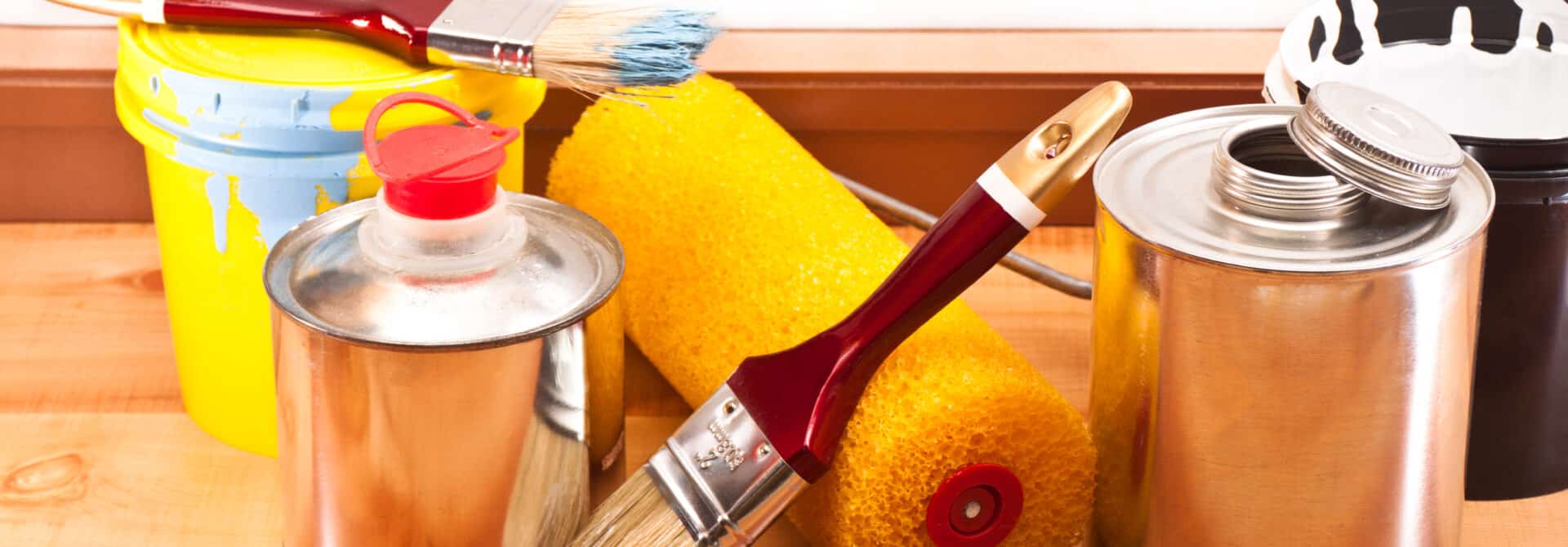
A Guide to Types of Paint Thinners
Types of Paint Thinner, Proper Usage, and More
Paint thinners are versatile tools in any painter’s arsenal. They help you achieve the perfect paint consistency, clean brushes effectively, and even remove stubborn paint residues. But with a variety of options available, navigating the world of paint thinners can be confusing. This guide explores everything you need to know – from the different types of paint thinners and their uses to safe handling practices and eco-friendly alternatives.
What is Paint Thinner?
In essence, paint thinner is a solvent used to thin paint products, making them easier to apply and spread smoothly. It also comes in handy for cleaning paint brushes, rollers, and other painting equipment, or even removing paint splatters and drips from surfaces.
The Two Main Types of Paint Thinner: Oil Based vs Water-Based
The type of paint thinner you choose hinges on the type of paint you’re using:
- Oil-Based Thinners: These are specifically formulated for thinning oil-based paints, varnishes, and stains. Due to their strong solvents, they’re generally more hazardous. Proper ventilation is crucial for safe use.
- Water-Based Thinners: Designed for latex and water-based paints, they are less toxic and have a milder odor compared to oil-based thinners. This makes them a better choice for indoor projects where ventilation might be limited.
Beyond Oil and Water: 6 Specific Types of Paint Thinner
Within these two main categories, various types of thinners exist, each with unique properties:
- Acetone: A powerful solvent for tough jobs like removing dried paint or varnish, but highly flammable and toxic. Use with extreme caution and proper ventilation.
- Alcohol: Primarily used for dissolving shellac and removing varnish.
- Lacquer Thinner: Ideal for thinning lacquers and cleaning lacquer equipment.
- Turpentine: A natural solvent used for thinning oil-based paints and cleaning brushes. However, it has a strong odor and can irritate skin and eyes.
- Mineral Spirits: A versatile thinner for oil-based paints, varnishes, and cleaning brushes. Less toxic than some other options, but proper ventilation is still recommended.
- Toluene: A strong solvent used in specific industrial applications; not recommended for home use due to its hazardous nature.
Important Note: Always refer to the product label and manufacturer’s instructions for proper use and safety precautions when using any paint thinner.
What is in Paint Thinner?
The composition of paint thinners varies depending on the type. However, some common ingredients include:
- Hydrocarbons: These are the main solvents in most paint thinners. Examples include mineral spirits, aliphatic hydrocarbons, and aromatic hydrocarbons.
- Alcohols: Alcohols like ethanol and methanol are sometimes used in thinners, particularly for water-based paints or shellac.
- Ketones: Acetone is a common ketone used in paint thinners, especially for tough cleaning jobs.
- Esters: Some thinners may contain esters, which can help improve drying time and flow characteristics.
It’s important to note that many paint thinners are flammable and can be harmful if inhaled or absorbed through the skin. Always use paint thinners in a well-ventilated area and wear appropriate safety gear, such as gloves, eye protection, and a respirator.
Environmentally Friendly Alternatives to Paint Thinner:
With a growing focus on environmental and health concerns, citrus-based thinners are emerging as a viable alternative. Derived from citrus peels, citrus-based thinners are natural solvents that offer a safer option for thinning paints and cleaning brushes. They’re biodegradable and less toxic than petroleum-based thinners, making them ideal for indoor use.
Thinner Safety Tips:
As we’ve mentioned throughout the blog, proper safety measures are important to take when using thinners. Here are a few more tips for you DIYers.
How to Dispose of Paint Thinner
Similar to disposing and recycling paint, doing so properly is important when working with paint thinner of any kind. Never pour paint thinner down drains or throw it away with regular trash. Here’s how to dispose of paint thinner safely:
- Check with your local waste disposal authority: They will have guidelines on safe disposal options in your area. There may be designated hazardous waste collection centers that accept paint thinners.
- Let leftover thinner evaporate in a well-ventilated area: If the amount of paint thinner is small, you can allow it to evaporate in a well-ventilated, safe location away from heat sources and open flames. Once completely evaporated, the container can be disposed of with regular trash.
Safety When Using Thinners
- Ventilation is Key: Always ensure proper ventilation when using paint thinners, especially oil-based ones. Open windows and doors or use a fan to create good airflow especially if you have apartment neighbors.
- Safety Gear: Wear protective gloves, eye goggles, and a respirator when using paint thinners to avoid inhaling fumes or skin contact.
- Keep it Flammable-Free: Paint thinners are flammable. Avoid using them near open flames, sparks, or heat sources.
- Stick to Legal Thinners: Thinners with methylene chloride are banned due to causing a number of different cancers.
Denver’s Trusted Painting Company
By understanding the different types of paint thinners and their properties, you can make informed choices for your painting projects. Consider eco-friendly alternatives like citrus-based thinners whenever possible to protect your health and the environment.
Ready to tackle your next painting project with confidence? Contact Paint Denver today for a free consultation and experience the quality and expertise that sets us apart!

